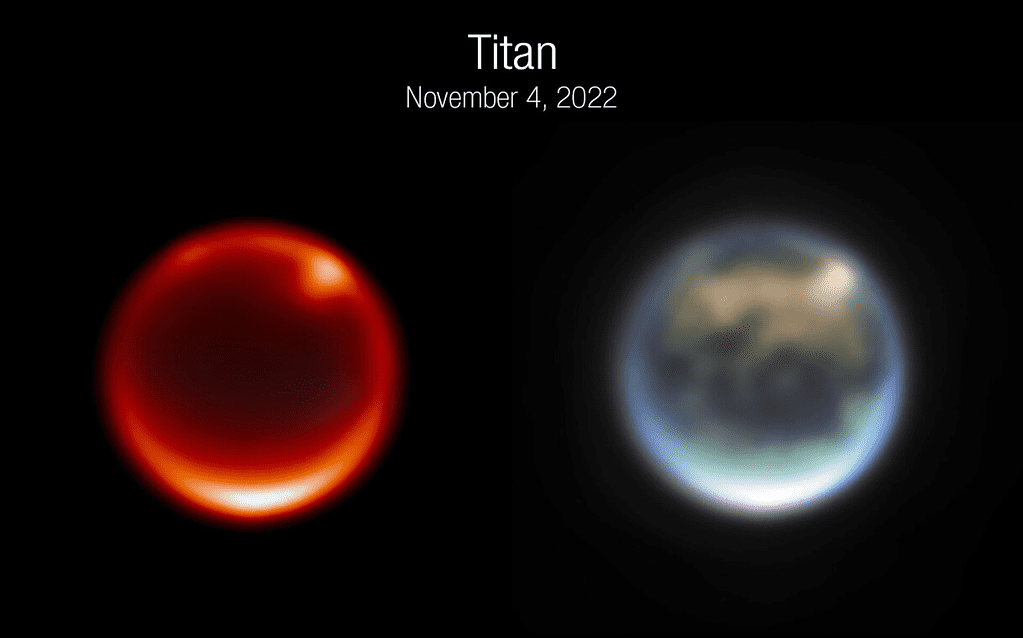In the relatively short time since it was launched, the James Webb Space Telescope has enabled us to peer farther into space than ever before, probing the very depths of the universe. But astronomers are also using it to check out things far closer to home — like Titan, one of Saturn’s largest moons. The initial images were puzzling, but when researchers looked at them more closely, the results were spectacular: the telescope imaged atmospheric clouds on Titan.

Titan is a weird and enigmatic place. It’s the second-largest moon of Saturn and the only moon in our solar system to have clouds — and dense clouds at that. The atmosphere on Titan is four times denser than Earth’s, and thick enough to capture heat, although overall, it’s still a freezing moon with temperatures of -290 degrees Fahrenheit (or -179 degrees Celsius).
Titan is at the same time remarkably similar to and different from Earth: it’s got liquids on its surface, vast bodies of liquid that run in rivers and form lakes and seas, and it’s even got rain that falls from the sky. It’s got exciting geological features like mountains, hills, or fluvial valleys. But unlike Earth, the landscape isn’t carved by water — the liquids are hydrocarbons like methane or ethane, and the moon has a hydrocarbon cycle instead of a water cycle. The atmosphere is also composed mostly of nitrogen (95%) and some hydrocarbons (5%), and it’s thick and hazy, shrouding the moon and making it hard for telescopes to peer through.
But the James Webb telescope doesn’t see like you or me — in other words, it doesn’t always use visible light frequencies. It can use infrared vision to peer through the atmosphere and spot information about weather patterns and the atmospheric composition, as well as the complex processes taking place over Titan’s surface.
Researchers like Sebastien Rodriguez from the Universite Paris Cité have been waiting for a tool like the James Webb telescope for a long time and the results don’t disappoint. Rodriguez was the first to see the new images when they arrived on Earth, and he excitedly told his colleagues in an email:
“What a wake-up this morning (Paris time)! Lots of alerts in my mailbox! I went directly to my computer and started at once to download the data. At first glance, it is simply extraordinary! I think we’re seeing a cloud!” JWST Solar System GTO Project Lead Heidi Hammel, from the Association of Universities for Research in Astronomy (AURA), had a similar reaction: “Fantastic! Love seeing the cloud and the obvious albedo markings. So looking forward to the spectra! Congrats, all!!! Thank you!”

The rest of the team quickly got in touch with researchers from the Keck Telescope on Mauna Kea in Hawai’i to perform follow-up observations.
Conor Nixon from NASA’s Goddard Space Flight Center wrote to Imke de Pater at University of California, Berkeley, and Katherine de Kleer at Caltech, who have extensive experience using Keck.
“We just received our first images of Titan from Webb, taken last night. Very exciting! There appears to be a large cloud, we believe over the northern polar region near Kraken Mare. We were wondering about a quick response follow-up observation on Keck to see any evolution in the cloud?”
After less than two days, they managed to point Keck towards Titan and found similar clouds, or quite possibly the same clouds Webb spotted.
“We were concerned that the clouds would be gone when we looked at Titan one and two days later with Keck, but to our delight there were clouds at the same positions, looking like they might have changed in shape,” said Imke de Pater, a UC Berkeley Professor of the Graduate School, in a press release.
“By using spectrometers on JWST together with the optical image quality with Keck, we get a really complete picture of Titan,” she said, such as the heights of clouds, the atmosphere’s optical thickness, and the elevation of haze in the atmosphere.

While we already knew that clouds can form on Titan, actually spotting them, especially with the James Webb telescope, is exciting. Titan can go years without forming any clouds, and Webb can use its infrared spectroscopy tools to reveal molecules and elements, finding clues that previously eluded observation.
In conjunction with recent modeling results, these observations bring a breakthrough in our understanding of the atmospheres of other celestial bodies. A new, even more exciting breakthrough could come with NASA’s new mission, which aims to actually send a robot to Titan.
“This is some of the most exciting data we have seen of Titan since the end of the Cassini-Huygens mission in 2017, and some of the best we will get before NASA’s Dragonfly arrives in 2032,” said Zibi Turtle of Johns Hopkins University, who is the principal investigator of Dragonfly — a planned spacecraft and NASA mission that will send a robotic rotorcraft to the surface of Titan, the largest moon of Saturn. “The analysis should really help us to learn a lot about Titan’s atmosphere and meteorology.”






